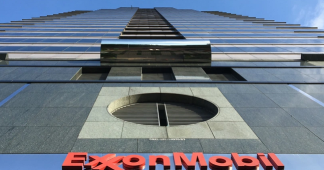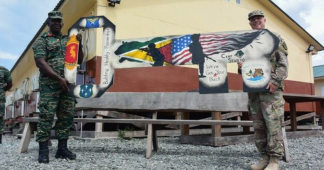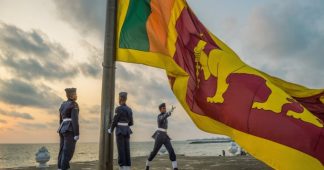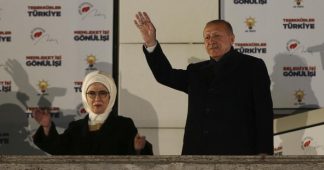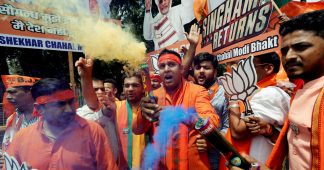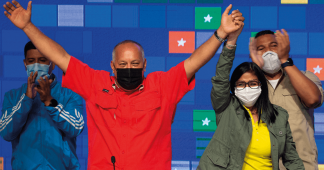31 Mar 2021
Guyana’s historically oppressed peoples direct their hostility at each other while neo-imperial powers hide in plain sight and reap the country’s wealth.
“Claims of absolute differences between the two major parties contending for state power are belied by their joint complicity as brokers overseeing the massive give-away of Guyana’s resources.”
In an ignominious first for the Commonwealth Caribbean, the aftermath of Guyana’s March 2020 general election dragged on with no officially declared result for five agonizing months. The voting itself had been long delayed: after the government was defeated in a no-confidence motion in December 2018, fresh elections were constitutionally required within three months unless an extension was obtained. But thanks to a series of court challenges and delaying tactics, the government bought itself another year in office in a caretaker role. Similar delays followed the voting, creating the unprecedented impasse.
It was not until August 2020 that Irfaan Ali, the candidate of the opposition People’s Progressive Party/Civic (PPP/C), was sworn in as president and his party was invited to form a new government. During the tense interregnum, the caretaker government seemed more interested in clinging to power than in responding to the Covid-19 pandemic. Racial hostilities—never far beneath the surface—played out in full view on social media, and sporadic violence erupted in various communities across the country.
As unusual as it was to have to wait five months for an election result, the underlying cause—racial division—is a long-standing problem that has dogged and on occasion convulsed the country. In the formative colonial period, racialized tensions were harnessed to an extractive sugar monocrop regime that delivered enormous wealth to the British imperial power.
Today, continuing internecine conflict masks entrenched privation produced by new extractivist and predatory capitalist models of economic development. Oil has emerged as the new sugar, and the political elites serve as managers on behalf of international capital. This is Guyana’s tragedy: historically oppressed peoples direct their hostility at each other while neo-imperial powers hide in plain sight and reap the country’s wealth.
Election Troubles
Guyana’s motto, “One people, one nation, one destiny,” adorns its coat of arms, complementing the country’s official name: the Cooperative Republic of Guyana. This is more aspirational than reality; few would dispute that sociopolitical relations in the republic are anything but cooperative. The contemporary politics of division among descendants of enslaved Africans, indentured Indians, the Indigenous population, and the few Portuguese and Chinese indentured laborers were produced and nurtured by the colonial administration as a central mechanism in the apparatus of rule, ensuring that the real business of wealth extraction could continue unimpeded.
Labor and other anticolonial movements of the early to mid-twentieth century awakened a broad and multiracial consciousness that found an outlet under the leadership of the charismatic Cheddi Jagan, a dentist turned social activist. The first election under universal suffrage was held in 1953, with eligibility to vote extended to all adults over 21 years of age. Jagan’s People’s Progressive Party (PPP) secured a landslide victory, winning 18 of the 24 legislative seats. Setting the tone for future elections, however, the grassroots triumph of 1953 and its promise of structural transformation evaporated quickly.
Barely four months into its term, the democratically elected government was unseated by an executive order from London. The British dispatched troops on the pretext of forestalling arson and unrest, though life in the colony was as normal as ever. A state of emergency was declared, assemblies were banned, and in a coup d’e ́tat from above, the Constitution was suspended. The state of emergency facilitated suppression of civil liberties, including the imprisonment of prominent members of the PPP.
The most damaging of these imperial machinations was engineering a split in the PPP along racialized lines. In Forbes Burnham, a charismatic Afro-Guyanese lawyer, the Colonial Office divined (incorrectly, as it turned out) a more palatable and moderate alternative to Jagan, and it actively connived to assist his ascension to power. Elections in 1957 were again convincingly won by the PPP, but this time there were two wings of the party—one led by Jagan and the other by Burnham—drawing support from what were becoming their respective ethnic bases. This was the genesis of an enduring racialized bifurcation in the colony’s political arrangements, but worse was to come.
After yet another PPP victory in a 1961 election, the United Kingdom—with US assistance—orchestrated and financed a program of destabilization. Strikes and social unrest morphed into rioting and communal violence, primarily between African and Indian Guyanese. The British imposition of a system of proportional representation in 1964 delivered the first PPP loss. Burnham’s People’s National Congress (PNC) joined with the United Force (UF), led by Peter D’Aguiar, a businessman of Portuguese descent, to form a coalition government. The Colonial Office finally granted Guyana political independence in 1966.
“The United Kingdom—with US assistance—orchestrated and financed a program of destabilization.”
Burnham’s initially legitimate acquisition of power in 1964 was the beginning of a long, repressive era in the country’s history. The first casualty was the UF partnership, which barely lasted two years. For more than two decades thereafter, the PNC remained in power by rigging successive elections, while the US and UK governments looked the other way. Burnham’s rule would come to an end only with his death in 1985, but free and fair elections did not return for another seven years. By that time, the Cold War had ended, and Guyana’s geopolitical signif- icance had temporarily waned.
The PPP united with a so-called Civic component and contested the 1992 election as the PPP/C, emerging victorious after 28 years in opposition. However, there was little break with the past, and even if subsequent elections were free and fair, they have certainly not been free from controversy. Another PPP/C victory in December 1997 was followed by a now-familiar pattern of demonstrations, looting, and racialized violence, which ended only after an intervention by representatives of the intergovernmental Caribbean Community (CARICOM). The brokered truce, dubbed the “Herdmanston Accord,” mandated constitutional reform within a strict time frame and fresh elec- tions immediately thereafter, truncating the PPP/C’s term by almost two years. Yet elections in 2001 and 2006 delivered successive PPP/C victories, albeit with declining majorities.
The Alliance for Change (AFC), a new political party formed in 2005 by defectors from both the PPP/C and the PNC, performed surprisingly well in the 2006 election, garnering six seats. It managed to add another seat in the next election, in 2011—when, for the first time in its history, the PPP/C had to form a minority government, though it retained the presidency by virtue of winning a plurality of the vote.
After almost a decade of violence that heightened racial tensions in the country, the administration faced mounting evidence of its corruption and racial patronage, and was unable to pass legislation easily. With rumors swirling that the AFC intended to table a no-confidence vote, then-President Donald Ramotar preemptively prorogued Parliament in November 2014. Riding the crest of their tactical successes, the PNC and AFC, along with the remaining smaller parties, joined forces in a grand coalition dubbed A Partnership for National Unity (APNU). In the next election in 2015, the combined opposition was finally victorious, unseating the PPP/C after its 23 consecutive years in government. Once again the margin was slim—less than 5,000 votes— which translated into a mere one-seat majority in Parliament.
Given this volatile history, there was little reason to expect any dramatic change, and in fact none materialized. One of the first acts of the new coalition government was to authorize substantial pay increases for ministers, even as wages in the public sector remained low. Former and currently serving military men were installed in key positions throughout the government.
These actions paled next to the abrupt closure of several sugar estates, a process that had already been started by the previous administration, but whose accelerated completion by the coalition government, with no safety net or alternative in place, plunged thousands into unemployment and instant poverty. Given that the affected constituency predominantly comprised Indo-Guyanese, reliable supporters of the opposition PPP, it was impossible to ignore the racialized subtext of this decision. It would be a disastrous miscalculation, contributing in no small measure to the coalition’s defeat in the 2020 election.
An Epic Standoff
When the chairman of the Elections Commission retired in December 2016, the controversy that erupted over the selection of his replacement exposed the hollowness of the coalition’s claims of national unity, as well as President David Granger’s disregard for constitutional processes. Granger rejected three lists of candidates submitted by the leader of the opposition—many of them outstanding citizens with impeccable records of service—as “not fit and proper,” before making a unilateral appointment. Ensuing litigation resulted in the appointment being invalidated as flawed and unconstitutional by the Caribbean Court of Justice (CCJ). Only then were the president and leader of the opposition able to agree on a replacement, more than two and a half years after the position became vacant.
Capitalizing on its resounding win in local government elections in 2016, the first to be held in 22 years—and in which low turnout in traditional PNC constituencies signaled some dissatisfaction with the coalition’s performance—the PPP/C tabled a motion of no confidence in the coalition government on December 21, 2018. Its passage with a slim majority of 33 votes was a seismic turn of events, made possible by a member of the ruling coalition who voted with the opposition, and later explained his decision with reference to the catastrophic impacts of the sugar estates’ shuttering. An inherited feature of British constitutional practice institutionalized in Guyana’s Constitution, a successful no-confidence motion requires the government to resign and call elections within three months. Instead, the coalition government pursued fruitless litigation in a seemingly endless pattern of resorting to the courts to address intractable political issues.
One of its more specious arguments, rejected by the chief justice and on final appeal at the CCJ, was that a parliamentary majority had to be obtained by rounding up from half the number of seats, from 32.5 to 33, and then adding one to make 34. In what seemed more like an elementary lesson in mathematics than high constitutional reasoning, the CCJ’s president concluded that the motion had been validly passed, noting drily that “majority” means the greater of two parts.
This defeat prompted no urgency on the part of the coalition government to call elections or seek an extension of the deadline, as was constitutionally required. The parties returned to court, and though the CCJ exercised tremendous restraint by declining to impose any time line for elections, it warned that the rule of law applied to all branches of government. It added that the meaning of the constitutional provisions in question was crystal clear, and that the government was now in an interim period, expected to govern only in a caretaker capacity.
The coalition government would dither for another eight months, eventually scheduling the elections for March 2, a full year after they should have been held. Even then, it would take another five months for an official result. This last delay was triggered by a blatant attempt on the part of Elections Commission officials to distort the outcome. They declared vote totals for one of the country’s ten regions—traditionally the strong- hold of the coalition government—that did not correspond with the votes counted at the polls, and that would have given the incumbent a victory by a margin of some 7,000 votes.
This maneuver drew swift condemnation from the opposition, civil society, and international and regional observer missions, and precipitated a series of court challenges by private citizens, with backing from both political parties, again seeking judicial remedies to a political crisis. A CARICOM delegation led by Barbadian Prime Minister Mia Mottley persuaded Granger, the care- taker president, to agree to a recount supervised by the regional organization. This was initially stymied by litigation challenging the terms of the CARICOM observer mission, and the recount did not get underway until May 6. A month later, it confirmed the PPP/C victory.
The chief election officer, acting on his own discretion, then attempted to invalidate more than 100,000 votes cast for the PPP/C, citing alleged irregularities revealed during the recount. This, too, prompted litigation that proceeded all the way to the CCJ. Reversing an appeals court decision, the CCJ ruled that this unilateral action was unjustified, paving the way for an official declaration of the election results. Yet it was only when the US State Department began in late July to impose sanctions on unnamed senior members of the coalition government that the Elections Commission moved to conclude its work, which finally enabled the swearing in of Irfaan Ali as president on August 2.
Colonialism’s Legacies
While the adversarial racialized context is a key to understanding Guyana’s serial inability to con- duct peaceful elections that earn public confidence, another crucial factor is the constitutional framework, which is manifestly unsuited to the country’s demographic realities. Among the features that have amplified the risks of authoritarianism and ethnic triumphalism is the absence of mechanisms for compromise and inclusion. Another is a hybrid arrangement that confers enormous power on an executive president.
The Westminster-style winner-take-all electoral model favors a two-party system at the expense of moderate smaller parties. Transplanted onto a racially polarized country where ethnicity is the most important determinant of political support, this system produces elections that have come to reflect demographics rather than parties’ track records in and out of office.
These structural deficiencies were amplified by the 1980 Constitution (imposed after a rigged referendum in 1978), which instituted a semi- presidential system, adopting the most undemocratic features of both parliamentary and presidential models of government. The positions of head of state and head of government were merged in an executive presidency with vast powers, insulated by extensive immunities. Since the legislature and executive remained fused as in parliamentary models of government, there would be little chance of cabinet members or members of Parliament acting as a check or balance. A compliant judiciary and weak civil society left no avenue by which the president could be held accountable.
These legal and constitutional structures facilitated Forbes Burnham’s increasing autocracy.
The reforms enacted pursuant to the Herdmanston Accord of 1998 focused less on the structural deficiencies of the system than on their symptoms. The constitutional and electoral status quo was retained, ensuring that winner-take-all elections would result in a presidency ascendant over every other branch of government. Additions to the Constitution of palliatives such as aspirational statements in the preamble and expanded human rights provisions were far too peripheral to resolve the fears of ethnic groups in the “losing” camp that they would be subject to political and economic exclusion.
Guyana’s weak economic base, volatile ethnic relations, and unsuitable constitutional and legal framework have combined to generate enduring political and social instability. There has never been any reckoning over the violence of the early 1960s, leaving parallel narratives of that traumatic period unmediated and unassuaged, with each group holding on to its own version of injury and injustice—what Trinidadian sociologist Rhoda Reddock calls “competing victimhoods.”
Meanwhile, successive governments have each embraced the unaccountable executive powers conferred by the Constitution, resulting in cycles of patronage and exclusion. Free and fair elections consistently deliver a razor-slim majority in the National Assembly, indicating monolithic blocs of African and Indian support for each of the two main parties, irrespective of their actual performance in office. Such evenly balanced ethnic polarization, combined with separate narratives of injustice and exclusion, has been a perfect recipe for combustion, which is reliably catalyzed by elections every five years.
Oil’s False Promise
Zero-sum polarization has left the Guyanese people vulnerable to the latest round of resource extractivism, whose organizers once again stand to profit from these intractable political divisions. This political-economic nexus is encapsulated by the symmetry of two moments, both of which occurred during recent periods of political transition, demonstrating the dramatically heightened stakes in the competition for state power.
The first was the May 2015 announcement by ExxonMobil, just days after the coalition government took office, of a major discovery of oil reserves in the Stabroek Block (current estimates put
the figure at more than 8 billion barrels of crude oil equivalent), located some 120 miles off the Guyanese coast. The second was the commencement of oil production in December 2019, the same month that Guyana’s Parliament was finally dissolved in preparation for the March 2020 elections. The discovery has been touted as a windfall for a country with a population of just 800,000.
While today’s new trickle-down king is oil, the predatory model of primary resource exploitation—whether it involves sugar, bauxite, gold, diamonds, or forestry—follows a familiar pattern of patronage and corruption. The main beneficiaries are foreign-based multinational corporations and a few key local private actors. Claims of absolute differences between the two major parties contending for state power are belied by their joint complicity as brokers overseeing the massive give- away of Guyana’s resources, a hemorrhaging that continues irrespective of who is in office.
In 1999, the PPP/C government secretly awarded a contract including a ten-year petroleum prospecting license to Esso Exploration and Pro- duction Guyana Limited (EEPGL), a consortium including Exxon as oilfield operator. The license covered 6 million hectares, more than 11 times
the legal limit, in water depths ranging from 200 to 3,000 meters.
The APNU–AFC coalition government, after taking over in 2015, continued its predecessor’s secretive approach to the dispensation of national patrimony. Only after sustained public pressure did the government publish the updated Production Sharing Agreement (PSA) it had signed with EEPGL 18 months earlier, in June 2016. Exxon holds 45 percent, Hess 30 percent, and China National Offshore Oil Company 25 percent of the shares in the consortium.
Local environmental activists have characterized the PSA as the equivalent of handing a blank check to Exxon and its partners. Even the International Monetary Fund has described its terms as “generous to the investor.” Guyana is entitled to royalties of 2 percent of gross revenues and 50 percent of profit oil (what remains after recoverable costs are accounted for). But its position is undermined by provisions that enable Exxon to recoup 100 percent of its development costs (esti- mated at $960 million in 2019) as well as annual recoverable costs of up to 75 percent of revenues. The consortium and affiliated companies are also exempt from most taxes.
“Even the International Monetary Fund has described its terms as “generous to the investor.”
In addition, a new article in the updated 2016 agreement allows the contractor to maintain that its “overall economic benefits have been materially and adversely affected . . . whether directly or in- directly” if the Guyana government proposes any change in the contract, and to refer the matter to arbitration in the event of a disagreement. But economic benefits are not defined, and there is no guidance as to how material and adverse effects must be calculated and demonstrated. Another article in the 2016 agreement protects the consortium from any amendments made under Guyana’s Petroleum (Exploration and Production) Act or associated regulations. Taken together, these provisions pose a challenge to Guyana’s sovereign rights.
After coming to power in August 2020, ignoring calls to renegotiate this egregiously lopsided agreement, the PPP/C administration rushed to approve an environmental permit that cleared the way for Exxon to begin exploration of a new oil field, known as Payara, in the Stabroek Block. This followed the new government’s commissioning of a review process headed by Alison Redford, who had been forced to step down as premier of the Canadian prov-ince of Alberta following allegations of excessive travel spending. Her political party, the Progressive Conservatives, had reportedly received contributions from Imperial Oil, an Exxon subsidiary, from 2009 to 2014.
To be sure, oil has placed Guyana firmly on the geopolitical map, given the size of the proven reserves and its long-running border dispute— which includes the offshore oil production sites—with Venezuela. That Guyana has become an important jewel in the crown of fossil fuel neo- imperialism was clearly signaled by the September 2020 arrival of US Secretary of State Mike Pompeo. It was the first visit to Guyana by a US secretary of state, and was part of a Venezuela-focused trip that also took Pompeo to Suriname, Brazil, and Colombia—on the eve of what would turn out to be his country’s own controversial election. At a joint press conference with Ali, Pompeo emphasized that they had discussed “the need for democracy in Venezuela and an end to the illegitimate Maduro regime.” He also noted Guyana’s support for statements issued by the Lima Group, which has recognized opposition leader Juan Guaido ́ as Venezuela’s interim president in response to alleged election rigging by President Nicola ́s Maduro. The message was clear: Guyana is now expected to be a compliant junior partner not just in multinational-led extractivism, but also in Washington’s regional geopolitical projects.
In 1955, two years after the suspension of the Constitution by British colonial authorities, Guyanese poet Martin Carter wrote that “without racial cooperation in the face of imperialist power, we go nowhere.” This warning resonates more than ever today, when deeply partisan and racialized loyalties obscure the fact that Exxon needs Guyana more than Guyana or the world needs Exxon. In an October 2020 report, the Institute for Energy Economics and Financial Analysis, a US-based think tank, projected that Guyana’s oil revenue over the next five years would not be enough to “close deficits, support new spending, and build a Sovereign Wealth Fund.” It also warned that beyond this period the prospects for oil and gas, particularly Exxon’s assets, are bleak. As Guyanese lawyer and transparency advocate Melinda Janki has noted, Exxon is cutting capital expenditure and jobs worldwide in the face of declining prices and demand.
The Guyanese people have their hopes for deliverance on a three-card trick. Their futures are being mortgaged for generations to come, saddled with the development costs of a declining industry and the weight of massive debt behind the Oil Dorado promise of windfall revenues. There has been no proper environmental audit of the impact of deep-sea drilling on marine life and on Indigenous and local communities. The tragedy is that this unsustainable pillaging of the national patrimony is taking place in a country with one of the largest standing rain forests in the world, which has the potential to offer a radically different model of value and engagement at a time of existential climate crisis.
Breaking the Cycle?
In his inaugural address on August 3, 2020, Ali pledged that there would be a place for everyone in his new administration. Invoking the “true Guyanese spirit” of rising above party politics was meant to be reassuring after the drawn-out election dispute the country had just endured, but one could be forgiven for a sense of cynical de ́ja` vu. After all, in 1992, Jagan had called for unity at the opening of Parliament, just as the coalition government promised national unity and constitutional reform when it came to power in 2015.
Tentative hope that the country could be on the verge of a new dispensation was swiftly tempered by the APNU–AFC coalition’s continued insistence that the government was illegitimate, and its move to file a petition to overturn the election results even as it took its seats in Parliament. This was a surreal reverse replay of the events of 2015, when it was the PPP/C that declared fraud, called for fresh elections, and filed a petition that has yet to be heard. Now the government has refused to meet with the main opposition party until it recognizes the legitimacy of the PPP/C’s victory, and several Elections Commission officials and prominent members of the coalition have been charged with electoral fraud. Three smaller parties that formed a joint list to secure a rotating parliamentary seat have been more or less neutralized by the election of the Indigenous leader of the Liberty and Justice Party, Lenox Shuman, as deputy speaker of the House and his appointment as a ministerial adviser on civil aviation. And in an all-too-familiar move, there have been widespread purges, across government ministries, agencies, boards, and commissions, of officials associated with the former administration. The most prominent casualty of this recriminatory cycle was the director of the Environmental Protection Agency, by far the country’s most qualified expert on oil and gas, who was summarily sent on leave during the controversial review of the Payara oil field exploration plan and was later dismissed.
So what now, in the face of this political impasse and a wearying sense that Guyanese voters will head to the polls in five years surrounded by the same rancor and divisiveness? There have been calls for a government of national unity, as well as for comprehensive constitutional and electoral reform that could bring an end to majoritarian, winner-take-all politics. While there has been no shortage of reports and recommendations (most recently from the CARICOM observer team), the question is whether tinkering from the top can deliver genuine change. The political elites have demonstrated no interest in challenging a deeply exclusionary system that they played a fundamental role in creating and from which they have benefited greatly.
Electoral reform is necessary but inadequate on its own to accomplish a real transformation. As the late social activist Andaiye commented, “Too many Guyanese these days have a narrow view of politics, because politics has become so over- centralized in Guyana that everything is supposed to be about political parties and government so that we don’t even have what we call politics at the local level or in the sector or in the community or wherever that you live.” What is urgently needed is a more expansive understanding of, and approach to, politics from below. Article 13 of Guyana’s Constitution gestures to this aspiration, envisioning “increasing opportunities for the participation of citizens and their organizations in the management and decision-making processes of the State, with particular emphasis on those areas of decision-making that directly affect their well- being” as the foundation of an inclusionary and multiracial democracy.
There are examples of such engagement in Guyana’s post-independence history. The 1970s saw intercommunity conversations on race organized by the Indian Political Revolutionary Associates and the African Society for Cultural Relations with Independent Africa, and mobilizations to secure land for working-class citizens. The 2005 floods that affected some 40 percent of the country’s population prompted an overwhelming diaspora and local response; women undertook grassroots organizing across racial divisions to demand compensation and challenge the invisibility of unwaged female labor during the crisis. As the 2020 election standoff dragged on in the midst of the Covid-19 pandemic, Guyanese people raised funds and delivered relief supplies to coastal and Indigenous hinterland communities, offering glimpses of neighborliness and connection beyond partisan divides.
Environmental activists have been mobilizing against Big Oil and the bankrupt model of neo- extractivism. In October 2020, anticorruption activist Troy Thomas successfully challenged Exxon’s environmental permits, which had been issued with a duration of more than two decades. Thomas won a court order that requires the company to conform with local laws mandating a maximum period of five years for such permits.
Only by building and carefully sustaining connections across various struggles and historic divides will the Guyanese people begin to effectively challenge the dominant economic and political arrangements that are reproduced via the politics of racial disunity. Reforming this elitist and exclusionary political culture requires centering the self-organizing capacity of ordinary Guyanese citizens in their communities, homes, and workplaces as they grapple with the business of everyday living. Now that Guyana’s most recent electoral crisis has receded from the headlines and the voters are no longer needed by the major local and foreign players, even as the usual patronage politics keeps churning on behalf of the few, this is the slow, difficult, but necessary work of change to be done.
Arif Bulkan is a senior lecturer in the Faculty of Law at the St. Augustine campus of the University of the West Indies. Alissa Trotz is a professor of Caribbean studies and director of women and gender studies at the University of Toronto. This is a revised and expanded version of an essay that appeared in Guyana’s Stabroek News in June 2020.
This article appeared in the February issue of Current History.
Published at www.blackagendareport.com
